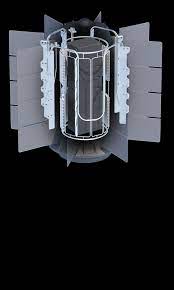Indian Space Research Organisation (ISRO) in collaboration with the Bhabha Atomic Research Center (BARC) 2 research organisation of India had jointly developed Radio thermoelectric generators (RTGs) with the purpose of decreasing the constraints of conventional chemical engines. Conventional chemical engines had limits to fuel capacity and solar power generation over long distances, whereas this collaboration is focussing on utilising the decay heat of radioactive materials like plutonium-238 or strontium-90.
Radio thermoelectric generators (RTGs)
Radio thermoelectric generators (RTGs) explained

| Component | Function |
|---|---|
| Radioisotope Heater Unit (RHU) | Generates heat through radioactive decay, releasing thermal energy. Initiates the heat-to-electricity conversion process. |
| RTG (Heat-to-Electricity Conversion) | Converts heat generated by RHU into usable electricity. Utilizes a thermocouple to generate a voltage from a temperature gradient. |
| Batteries | Converts heat generated by RHU into usable electricity. Utilizes a thermocouple to generate a voltage from temperature gradient. |
Radio thermoelectric generators (RTGs) News
Who developed a nuclear engine for rockets named Radio thermoelectric generators (RTGs)?
Indian Space Research Organisation (ISRO) and Bhabha Atomic Research Center (BARC) developed a nuclear engine for rockets named Radio thermoelectric generators (RTGs)
- Friday Night Plan Hindi Movie Teaser ( Experience the duo of brother friendship)
- Article 21 Malayalam Movie Review ( What is the price of education for all)
- Hindi Sexy Video (हिंदी सेक्सी वीडियो) Top 9 Sexy Video Hindi
- Israel’s Defense Ministry Fires ORON Aircraft
- Unknown: Cave of Bones review ( Who is the real history of humankind)

